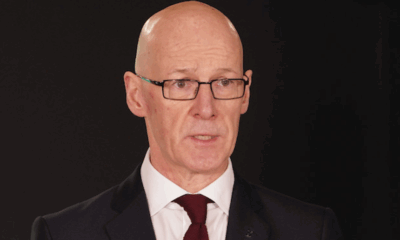Science
Controversy Arises Over Scatsta Hydrogen Development Agreement

The agreement between the Shetland Islands Council (SIC) and energy developer Statkraft to lease land near the former Scatsta Airport for hydrogen development has sparked significant debate. Announced on Wednesday, this deal could generate an annual income of £1.13 million for the SIC, along with a community benefit payment valued at approximately £2 million annually once the project is operational, anticipated by 2032.
The proposed facility aims to produce green hydrogen and ammonia, utilizing excess renewable energy, particularly from nearby wind farms. While the SIC views this as a substantial financial boost for the community, critics argue it represents a capitulation to corporate interests.
Community Benefit Agreement Draws Mixed Reactions
The SIC plans to manage the funds from the leasing agreement strategically, aiming to leverage them for further community projects. However, the terms of the community benefit have raised eyebrows. Green councillor Alex Armitage has been vocal in his criticism, describing the arrangement as a “sellout” to a large corporation for what he considers a trivial amount. “To say I’m disappointed is an understatement,” he remarked, expressing deep frustration over the council’s decision-making process.
In contrast, SIC leader Emma Macdonald defended the agreement, asserting it aligns with the principles outlined in the Fair Share for Shetland report. This document, approved earlier this year, aims to ensure that Shetland reaps the benefits of renewable energy initiatives. “It is critically important that we as a council do what we can to ensure the isles see a benefit if the projects proceed,” Macdonald stated.
The community benefit agreement includes a fixed payment of £5,000 per installed megawatt of capacity, mirroring the payout structure of the SSE’s Viking wind farm. However, critics like Armitage believe this falls short of the recommendations made in the Fair Share report, which suggested a minimum of 2.5 percent of gross revenue from hydrogen projects.
Concerns Over Strategic Direction and Leadership
The Fair Share for Shetland report, released in November 2022, proposed that community payments should be linked to production levels and indexed to inflation, suggesting a higher community benefit payment of around £7,300 per megawatt. Armitage insists that the SIC has ignored these recommendations, which could have strengthened community ownership of renewable resources.
Macdonald acknowledged that while there is no legal obligation for energy developers to provide community benefits, the SIC has developed a framework to guide negotiations. “Community benefit is a voluntary arrangement that we have no way to mandate,” she explained. “This particular arrangement is different as it is the first time that community benefit is being able to be used strategically by a local authority.”
Despite the SIC’s optimism, local councillor Andrew Hall expressed skepticism about the true economic impact of the hydrogen project. He remarked that the uncertainties surrounding hydrogen production make it difficult to predict how much it will benefit the local economy.
Statkraft’s principal hydrogen project manager, Stuart Marley, described the agreement as an “exciting milestone.” He emphasized the potential for Shetland’s renewable resources to drive innovative technology in hydrogen production. Marley noted that while the project is still in its early stages, Statkraft intends to collaborate closely with local stakeholders as development progresses.
The Scatsta project, if realized, will join other significant developments in the region, including the Sullom Voe Terminal and the Shetland Gas Plant. Plans for additional energy projects, like the proposed Neshion Energy Park, which includes battery storage, are also underway, indicating a growing focus on harnessing Shetland’s renewable energy resources.
As the debate continues, the SIC faces pressure to balance community interests with the potential benefits of large-scale energy projects. Armitage remains resolute, warning that without strategic oversight and a stronger community stance, Shetland risks losing control over its natural resources and future energy developments. “We can’t keep staggering on with the status quo. What we need now is real change to shift the balance of power in Shetland’s favour,” he concluded.
-

 Entertainment3 months ago
Entertainment3 months agoAnn Ming Reflects on ITV’s ‘I Fought the Law’ Drama
-

 Entertainment4 months ago
Entertainment4 months agoKate Garraway Sells £2 Million Home Amid Financial Struggles
-

 Health3 months ago
Health3 months agoKatie Price Faces New Health Concerns After Cancer Symptoms Resurface
-

 Entertainment3 months ago
Entertainment3 months agoCoronation Street’s Carl Webster Faces Trouble with New Affairs
-

 Entertainment3 months ago
Entertainment3 months agoWhere is Tinder Swindler Simon Leviev? Latest Updates Revealed
-

 Entertainment4 months ago
Entertainment4 months agoMarkiplier Addresses AI Controversy During Livestream Response
-

 Science1 month ago
Science1 month agoBrian Cox Addresses Claims of Alien Probe in 3I/ATLAS Discovery
-

 Entertainment4 months ago
Entertainment4 months agoKim Cattrall Posts Cryptic Message After HBO’s Sequel Cancellation
-

 Entertainment2 months ago
Entertainment2 months agoOlivia Attwood Opens Up About Fallout with Former Best Friend
-

 Entertainment3 months ago
Entertainment3 months agoMasterChef Faces Turmoil as Tom Kerridge Withdraws from Hosting Role
-

 Entertainment4 months ago
Entertainment4 months agoSpeculation Surrounds Home and Away as Cast Departures Mount
-

 World2 months ago
World2 months agoCole Palmer’s Mysterious Message to Kobbie Mainoo Sparks Speculation



















